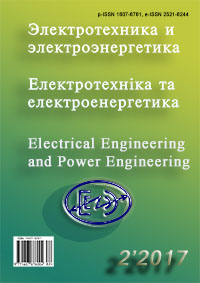THE METHODOLOGICAL APPROACH FOR CONSTRUCTION OF ENERGY-EFFICIENT EMERGENCY LIGHTING SYSTEM
DOI:
https://doi.org/10.15588/1607-6761-2017-2-7Keywords:
lighting system, energy-saving, emergency lighting, photovoltaic conversion, schematic realizationAbstract
Purpose. The research of methodological approach to construction of reliable and effective emergency lighting system, which works without the use of stationary electric networks from electricity, producible in result of photovoltaic conversion of artificial radiation from lamp of working (general) lighting in visible range of spectrum.
Methodology. The experimental researches concerned the construction of the energy-efficient emergency lighting system which works without the use of stationary power source are conducted.
Research results. As result of research the experimental model of lamp was constructed showing the possibility of emergency illumination realization on the base of the most widespread common illumination luminescent lamps of ceiling type due to electric power produced at conversion of luminescent lamps artificial light stream by the sun panels placed on their surfaces.
Originality. Within the bounds of developed methodological approach the first time it was shown the possibility of multifunction energy-efficient lamp construction combining the working and emergency illumination functions without the use of the stationary power systems.
Practical value. With use of the developed methodological approach on the base of standard constructions of the luminescent lighting systems it is possible to design the multifunction energy-efficient lamp, that will help to resolve the problem of energy-saving that gains in importance last years in connection with the all increasing electric power use including lighting needs.
References
Samburs, E. (2003) Plody osveshhenija. Stroitel'stvo i rekonstrukcija, 1-2, 28 – 29 (in Russian).
Pilipchuk, R.V., Jaremchuk, R.Ju. (2003) Problema energozberezhennja v osvіtljuval'nih ustanovkah. Svіtloljuks, 2, 10 – 13 (in Ukrain.).
Aizenberg, Ju.B. (2010) Jenergojeffektivnoe osveshhenie. Problemy i reshenija. Jenergosovet, 6(11), 20 – 26 (in Russian).
Ciplenkov, D.V., Krasovs'kij, P.Ju. (2015) Methods and means of technical losses reduction of electricity in the elements of power supply systems. Electrical Engineering And Power Engineering, 1, 77-82. DOI: 10.15588/1607-6761-2015-1-13.
D'jachenko, V.V. (2015) Creation of energy saving program for power supply systems. Electrical Engineering And Power Engineering, 1, 70 – 76. DOI: 10.15588/1607-6761-2015-1-12.
Sapryka, A.V. (2009). Povyshenie jenergojeffektivnosti osvetitel'nyh kompleksov s uchetom kachestva jelektricheskoj jenergii. Monografija. Har'kov: HNAMG, 126.
Yarymbash, D.S., Daus, Ju.V. (2014). Solar radiation intensity identification features for solar power stations designing. Electrical Engineering And Power Engineering, 1, 74 – DOI: 10.15588/1607-6761-2014-1-12.
Al'ferov, Zh. I., Andreev, V.M., Rumjancev, V.F. (2004) Tendencii i perspektivy razvitija solnechnoj jenergetiki. FTP, 38, 8, 937 – 942.
Pogosov, A. Ju., Dubkovskij, V. A. (2013). Ionizirujushhaja radiacija: radiojekologija, fizika, tehnologii, zashhita. M: Nauka I tehnika, 804.
Charl'z, P. (2017) Jenciklopedija jelektronnyh komponentov. S-Petersburg: BHV, 368.
Spektral'noe raspredelenie ljuminescentnyh lamp. (2000). Katalog istochnikov sveta OSRAM
Timchenko, S.L., Dement’eva, O.Ju., Zadorozhnyj N.A. (2015). Vlijanie spektra izluchenija na harakteristicheskie krivye solnechnoj batarei. Fizicheskoe obrazovanie v vuzah, 21, 1, 3–12.
Efimov, V.P. (2010). Fotopreobrazovateli jenergii solnechnogo izluchenija novogo pokolenija. FIP, 8, 2, 100 – 115 (in Russian).
Kosharov, A.A. (2014). Ionistor v avtonomnoj jelektricheskoj cepi. Sovremennaja jelektronika, 1, 38–40.
Andreev, V.M., Rumyantsev V.D., Karlina L.B., Khvostikov V.P. (1997). Tandem Solar Cells Based on A3B5 Compounds. Thermal Engineering, 44, 273–278.
Krukovskij, S.I., Nikolaenko, Ju.E. (2003). Solnechnye jelementy na osnove tandemnyh geterostruktur GaAs-InGaAs-AlGaAs. Tehnologija i konstruirovanie v radiojelektronnoj apparature 6, 39 – 41.
Lunin, L.S., Pashhenko, A.S. (2011). Modelirovanie i issledovanie harakteristik fotojelektricheskih preobrazovatelej na osnove GaAs i GaSb. FTT, 81, 9, 71 – 76 (in Russian).
Lavrich, Ju. N. (2013) Issledovanie vlijanija dlitel'nogo hranenija na harakteristiki solnechnyh batarej. Napіvprovіdnikovі materіali, іnformacіjnі tehnologії ta fotovol'taika. Kremenchuk, 79 – 81.
Downloads
Published
How to Cite
Issue
Section
License
Copyright (c) 2018 Yu. Lavrich, L. Pogorelaya, A. Podchasov

This work is licensed under a Creative Commons Attribution 4.0 International License.
Creative Commons Licensing Notifications in the Copyright Notices
Authors who publish with this journal agree to the following terms:
Authors retain copyright and grant the journal right of first publication with the work simultaneously licensed under aCreative Commons Attribution License that allows others to share the work with an acknowledgement of the work's authorship and initial publication in this journal.
Authors are able to enter into separate, additional contractual arrangements for the non-exclusive distribution of the journal's published version of the work (e.g., post it to an institutional repository or publish it in a book), with an acknowledgement of its initial publication in this journal.
Authors are permitted and encouraged to post their work online (e.g., in institutional repositories or on their website) prior to and during the submission process, as it can lead to productive exchanges, as well as earlier and greater citation of published work.

